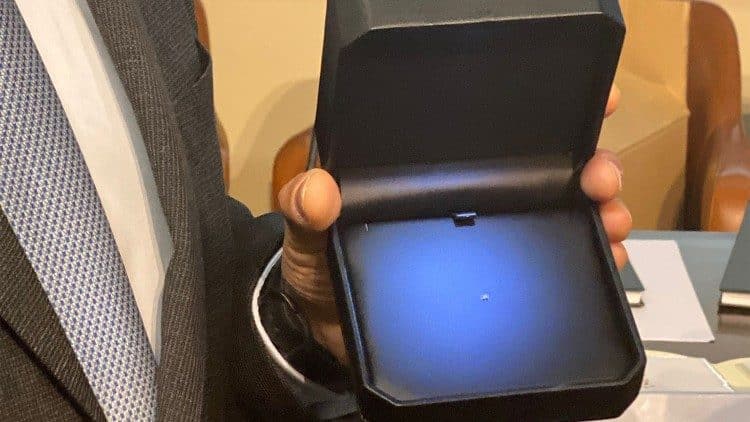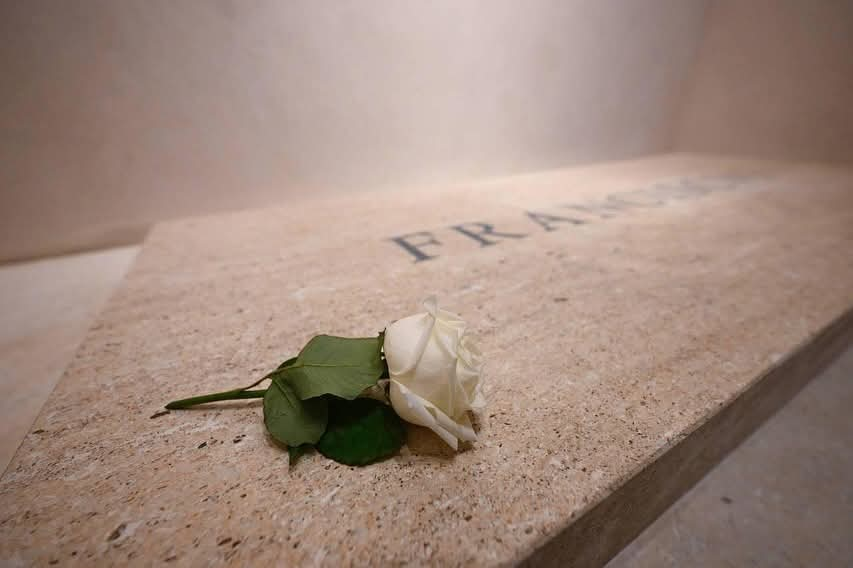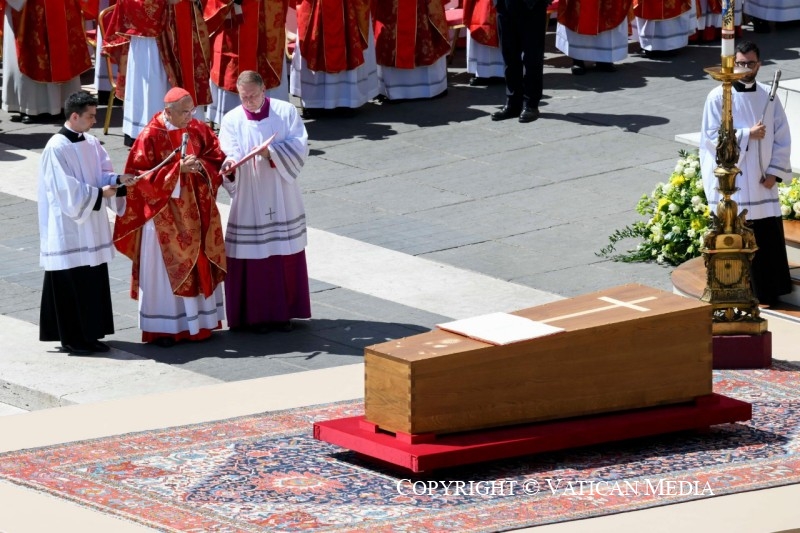‘Nanobook’: ‘Why are you afraid? You still don’t have faith’
The 'Spei Satelles' project starts on 10 June

PRESS RELEASE
SPEI SATELLES: A MESSAGE OF HOPE FOR ALL HUMANITY
On 10 June 2023, from the Vandemberg Space Force Base in California, the “Spei Satelles” project will lift off aboard a rocket: a CubeSat built by the Polytechnic University of Turin and operated by the Italian Space Agency will enter orbit to carry a message of hope and peace enshrined in a nanobook made by the National Research Council. The initiative, promoted by the Holy See’s Dicastery for Communication, ties in with the Pope’s message on 27 March 2020, delivered at the Statio Orbis in St. Peter’s Square. That moment of prayer has become an icon of hope that continues its journey to call the people of the planet to action. To embody this common commitment, walking together with the Pope, anyone who so desires can join the journey of “Spei Satelles” and become a bearer of hope and peace by registering their name at www.speisatelles.org. On Wednesday, 29 May, at the end of the General Audience, the Holy Father will bless the satellite and the nanobook before it undergoes the final technical checks before launch.
At the height of the pandemic, on 27 March 2020, Pope Francis walked through St. Peter’s Square in the rain, amid the gathering darkness of the evening, to pray with and for all humanity enduring the scourge of Covid-19. As he entered the Temple, he prayed and blessed the entire people of God, dispersed throughout the world but gathered in heart, hope, and prayer with him in the Square. This event was the Statio Orbis.
From that day on, a host of initiatives were born to keep this unique event in the minds of all people, through the initiative of the Dicastery for Communication, led by the Prefect, Paolo Ruffini, and the Secretary, Msgr. Lucio Adrian Ruiz. In 2021, the publication of the book Why Are You Afraid? Have You No Faith? encapsulated the most important words and images of that event, offering a sign of the tenderness and blessing that the Holy Father sought to convey to all humanity amidst a period of existential difficulty.
Then, in 2022, a “mini” edition (10 x 8 cm) of the book was deposited at the Svalbard Global Seed Vault, on the Norwegian island of Spitsbergen, registered as a “seed of hope.” This event also marked the beginning of a larger project, carried out with the Instituto para el Diálogo Global y la Cultura del Encuentro – IDGCE, which aims to establish 27 March as the World Day of Hope.
On the third anniversary of the Statio Orbis, and the 10th anniversary of Pope Francis’ Pontificate, the Dicastery for Communication worked with various people and organizations to launch together a renewed sign of hope, starting from that first seed. Thus was born the the “Spei Satelles” space mission project, coordinated by the Secretary of the Dicastery, Msgr. Lucio Adrian Ruiz, which involves the National Research Council (CNR), the Italian Space Agency (ASI), the Polytechnic University of Turin, the Instituto para el Diálogo Global y la
Cultura del Encuentro – IDGCE, the Salesian University Institute Venice – IUSVE, and the Digital Apostolate of the Archdiocese of Turin.
The Pope’s book – Why Are You Afraid? Have You No Faith? – which carries the message of the Statio Orbis, has become, thanks to the National Research Council and in particular to the work of the Institute of Photonics and Nanotechnology coordinated by Dr. Andrea Notargiacomo, a “nanobook” (a silicon plate, measuring 2x2x0.2 mm), in which the book was engraved using extreme miniaturization by means of micro- and nano-fabrication technologies.
The Italian Space Agency and the Polytechnic University of Turin have then worked in close synergy to place this nanobook into orbit, as a sign and prophecy of hope.
Students from the University of Turin, led by Professor Sabrina Corpino, designed and built in record time the SpeiSat 3U CubeSat which would house and safeguard the nanobook. The Italian Space Agency, led by Giorgio Saccoccia, has coordinated the project and made it possible to launch the CubeSat and put it into Low Earth Orbit (LEO) at an altitude of about 525 km.
The launch is scheduled for 10 June 2023 from Vandenberg Space Force Base (VSFB) in California, USA. The CubeSat will travel aboard a Falcon 9 rocket, SpaceX’s partially reusable two-stage launch platform and will be hosted on the ION SCV-011ION platform, the satellite carrier developed, built and managed by the Italian company D-Orbit, which performs launch and release in-orbit services.The satellite is equipped with a radio transmitter, as well as on-board instruments to be maneuvered from the ground. For the period in which the satellite is in orbit, it will broadcast easily-decipherable messages in English, Italian, and Spanish containing phrases taken from the Pontifical Magisterium focused on hope and peace, as it flies around the Earth.
The mission is also designed to offer encouragement to people to get involved. The website www.speisatelles.org offers people the possibility to follow the mission’s progress, as well as the opportunity to register their name in a dedicated memory chip which Spei Satelles will keep in orbit. In order to obtain a virtual boarding pass, those interested will be asked to pledge to do a work of mercy on behalf of peace and hope. Each person involved can thus become a concrete seed of hope in their daily lives.
The logo of the space mission recalls each of these various aspects. The logo was created as part of an educational project by students of the Salesian University Institute of Venice – IUSVE, led by Marco Sanavio. First of all, the logo recalls the initials of Spei Satelles, which means Guardian of Hope in Latin. The two letters “S,” arranged in a mirrored pattern, indicate the complementarity of “earth” (the lower semicircle) and “heavens” (the upper semicircle), as well as denoting the satellite’s orbit around our planet. Another dashed orbital track farther from the center, composed of 59 lines to signify the beads of the Rosary, joins three figures which represent the three great realities present in St. Peter’s Square on the evening of 27 March 2020:
• the cross (shown in the logo with curved sides as if to represent a star): the largest and most important element of the three, indicating the presence of Christ the Savior and recalling both the Cross of St. Marcellus and the Monstrance containing the Eucharist with which Pope Francis blessed humanity in the empty Square;
• the 12-pointed star: representing the presence of the Virgin Mary, invoked under her title of Salus Populi Romani;
• the smaller triangle: recalling the figure of the Holy Father as he climbed the steps of the Square’s parvis.
The three dots appearing over the outermost orbital track are a sign of the presence of the Trinity, as is the threefold proclamation of the passion, death and resurrection in the synoptic Gospels, a message which gives hope to humanity.
The various technical and meaningful elements of technology and storytelling were coordinated and joined thanks to the work of the Digital Apostolate of the Archdiocese of Turin, led by Msgr. Luca Peyron.
Several of the protagonists of this space venture, which begins today, offered the following remarks:
ASI President Giorgio Saccoccia points out that: “The Holy See has asked the Italian Space Agency to help it identify and implement, using to space technology, a solution that would allow the Holy Father’s words of hope to cross the earth’s borders and reach from space the greatest possible number of women and men on our troubled planet. For those of us who are used to seeing space as the privileged place from which to observe the world and communicate with it without borders, it was easy to imagine a quick, humble and effective solution to offer wings to the Holy Father’s message. Thus, Spei Satelles was born, conceived in such a way as to be implemented and managed by young people, the first recipients of the message of trust that Pope Francis sought to offer the world on 27 March 2020. This represents of union of faith and technology to nurture hope in a better future.”
Professor Guido Saracco, Rector of the Polytechnic University of Turin, an institution which has also spent a great deal of effort on behalf of Spei Satelles, says: “The Spei Satelles program, with the design and construction of the satellite and the subsequent mission control, represents an extraordinary opportunity for our university, especially for our students and researchers led by Professor Sabrina Corpino. Our young people were able to measure themselves against a technical and scientific challenge that was not easy in a value framework that represents a decisive human and cultural challenge. The message that the Polytechnic welcomes and relaunches with this project is that science and technology can and should be united in alliance as bearers of a message of hope and peace for the whole world. We all have in mind 27 March 2020, and what we were experiencing. Our young people have built a technological artifact that, starting from that iconic moment, will speak to the world and allow every person to be a protagonist of universal hope and fraternity together with Pope Francis.”
The Metropolitan Archbishop of Turin, Archbishop Roberto Repole, emphasizes that: “We all need hope, especially young people. Keeping hope is the mission of this satellite designed and built by young people, told in the logo mission by young people, inhabited, we hope, by many young people who will want to get on board with the Pope through the site thus committing themselves to sowing hope and fraternity where they live. We are pleased to have contributed with the university pastoral ministry and the digital apostolate of our diocese to ensure that an intuition of Pope Francis could be made concrete as a testimony as much to ecclesial communion as to the desire of believers to enter more and more into dialogue with the world especially in the area of science and technology.”
Maria Chiara Carrozza, the President of CNR, said: “Today the science of the infinitely small confronts us with enormous progress: the ability to miniaturize our knowledge by making it travel through time and space. Scientific research accompanies humanity’s journey by identifying solutions to improve the quality of life, the well-being of societies, and the health of the planet. But it is also an instrument of dialogue thanks to which we break down barriers and build hope: an aspect, this one, particularly important in the moment of conflict we are going through.”
Msgr. Nicola Giacopini, the Director of IUSVE, said: “We are grateful and almost incredulous to have been so closely involved in this experience which unites earth with heaven. Our young Communication students and graduates were able to try their hand at logo design and storytelling for the Spei Satelles mission. In our teaching efforts, we work every day through symbolic communication, which is also proper to religious language, to make the messages we wish to convey accessible and as universal as possible.”
Related

Cardinal Parolin at the Novendalia Mass: “Mercy leads us to the heart of faith”
Exaudi Staff
27 April, 2025
8 min

Pope Francis’ Tomb in Santa Maria Maggiore
Exaudi Staff
27 April, 2025
1 min

Mercy and the joy of the Gospel are two key concepts of Pope Francis
Exaudi Staff
26 April, 2025
9 min

Thousands of faithful bid farewell to Pope Francis in St. Peter’s Square
Exaudi Staff
26 April, 2025
2 min
 (EN)
(EN)
 (ES)
(ES)
 (IT)
(IT)

